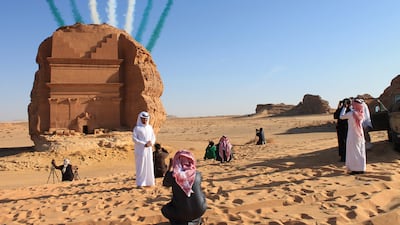RIYADH // It’s the day before the grand opening of Shaden, a luxury desert camp in Saudi Arabia where air-conditioned tents look out on sandstone cliffs. A princely delegation is on its way. But the place isn’t quite ready.
Peacocks for the garden of the 10,000-riyals-a-night royal suite have not arrived. The cow brought in to provide fresh milk for the cafe has been mooing all night. “He won’t shut up,” laments Ahmed Al Said, the project developer, as he gives orders over the clang of hammers and shovels.
Saudi Arabia as a whole isn’t ready for tourists either. But its rulers are intent on revolutionising the economy, and tourism is high on their list. They figure it can create jobs for a youthful population, earn revenue to reduce oil-dependence, and help open the kingdom to the world. Which it might – if anyone can be persuaded to come.
The country attracts plenty of foreign travellers – about 18 million last year, the most in the Arab world. But they are almost all Muslim pilgrims visiting Mecca. Regular tourism barely exists.
Saudi Arabia does not even issue tourist visas. Its alcohol ban, strict dress code and curbs on gender mixing are red flags for many people who would be happy to visit Dubai’s beaches or Egypt’s pyramids.
Then there are the secret police, who often keep a close watch on foreign visitors, and the religious police, who chastise people for moral violations.
“There are aspects of Saudi that will put people off,” said Jarrod Kyte, product director at UK tour company Steppes Travel.
Not all people, though – which is why Steppes is offering its first tour to Saudi Arabia next month. It cost almost US$6,000 (Dh22,000) per person, and was hard to arrange because it required invitational visas. But Mr Kyte said it was irresistible to seasoned travellers who wanted to check an unusual country off their list. He is hoping to do it again: “It became very apparent there was demand there.”
That is what the Saudi government is keen to capitalise on. Its post-oil plan, known as Vision 2030, includes measures to encourage the entertainment industry and develop coastlines and historical sites – like Al Ula, where the Shaden resort is going up. Nearby are the 2,000-year-old ruins of Mada’in Saleh, a relic of the same ancient civilization that built the better-known city of Petra in Jordan.
In charge of the tourism drive is Prince Sultan bin Salman, head of the Saudi Commission for Tourism and National Heritage and a son of the king. He said the kingdom is finally waking up to ideas he has been promoting for years.
“A lot has been invested, not in the tourism sites as we would like to see it, but the supporting infrastructure – airports and roads and so on,” Prince Sultan said in Riyadh. He dismissed concerns that opening up the conservative kingdom to foreigners would cause trouble.
“People would say the social environment isn’t right,” he said. “I keep telling them: the social environment will follow. And that is what’s happening today.”
Prince Sultan reels off a list of museums that are about to open and others he plans to commission. They will let Muslims learn about Islam in the place where it was born, he said. The religious dimension may help win backing from Saudi Arabia’s powerful clerics, who often oppose change.
Investment in cultural heritage is underway too: the government has set aside 5 billion riyals (Dh4.77bn). It’s also encouraging private spending by companies like Jeddah-based Al Jazirah Safari, which is building the Shaden resort, a 100 million-riyal project.
Some Saudis who live there are looking forward to the opportunities. Farmer Ahmed Al Masoud plans to turn his orange groves into a resort where he will teach tourists about traditional agriculture. Businessman Faras Al Harby is importing souvenirs from China.
They are all waiting for one thing: tourists. On a recent afternoon, 56-year-old Birgit Mitchell had the place pretty much to herself. An American teacher who lives in Saudi Arabia, she took the bus there, playing her guitar for Saudi women at rest stops along the way. “Wow, I can’t believe we can just walk here,” she said, popping in and out of the carved tombs.
Most visitors are Saudi residents, like Ms Mitchell, or citizens of other Gulf countries, who do not need visas. The government has not said when it will start issuing tourist visas.
“The visa is the axis for the numbers that will come,” said Ahmad Al Fadhel, co-owner of another camp nearby. But he sees a chicken-and-egg problem with the government’s plans too: “Investors don’t want to come because tourists haven’t come, and tourists don’t want to come because the services haven’t come.”
Turmoil in the Middle East has kept visitors away even from established destinations like Egypt. Saudi Arabia – though more stable than many neighbors – is not immune. In 2007, four Frenchmen on their way back from Mada’in Saleh were killed by militants.
That is one reason local schoolteacher Ahmed Al Imam, who works part-time as a tour guide, does not plan to give up his day-job even if visa curbs are lifted and visitors pour in. “Imagine if I quit teaching,” he said, snapping his fingers, “and one night a crazy person did something wrong. Tourism will stop.”
The week the new camp opened, there was a programme of Saudi films in Al Ula – projected onto a cliff, because there are no movie theaters in the kingdom. There had been some grumbling beforehand about the corrupting influence of such a show. In the event, men and women gathered in their cars to watch, and vendors hawked tea under the stars.
* Bloomberg

